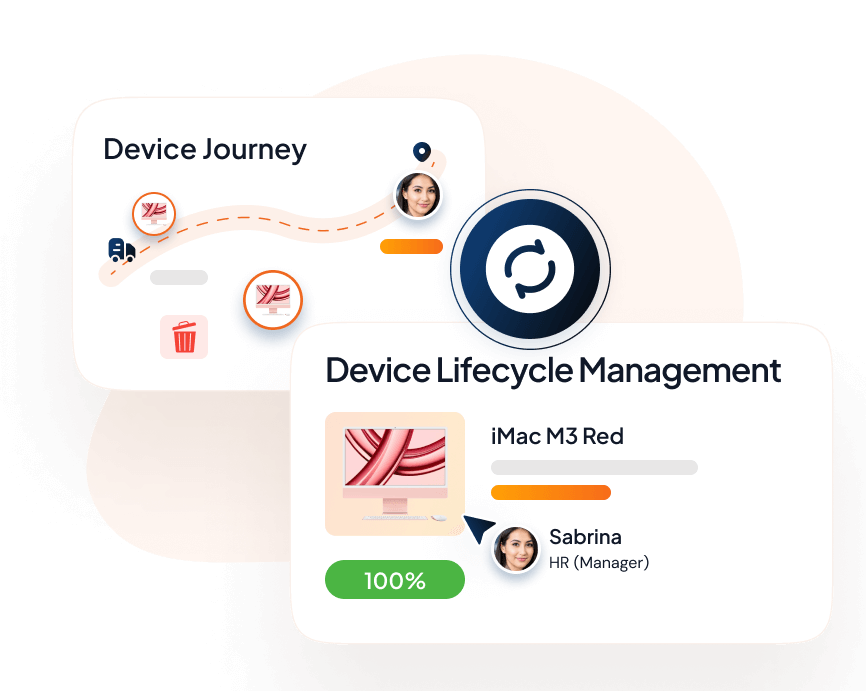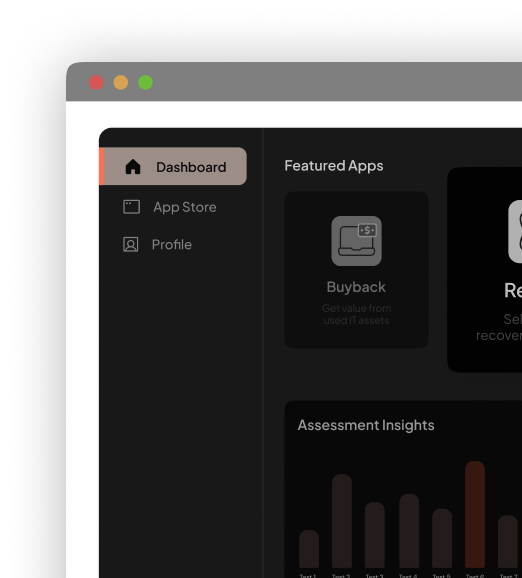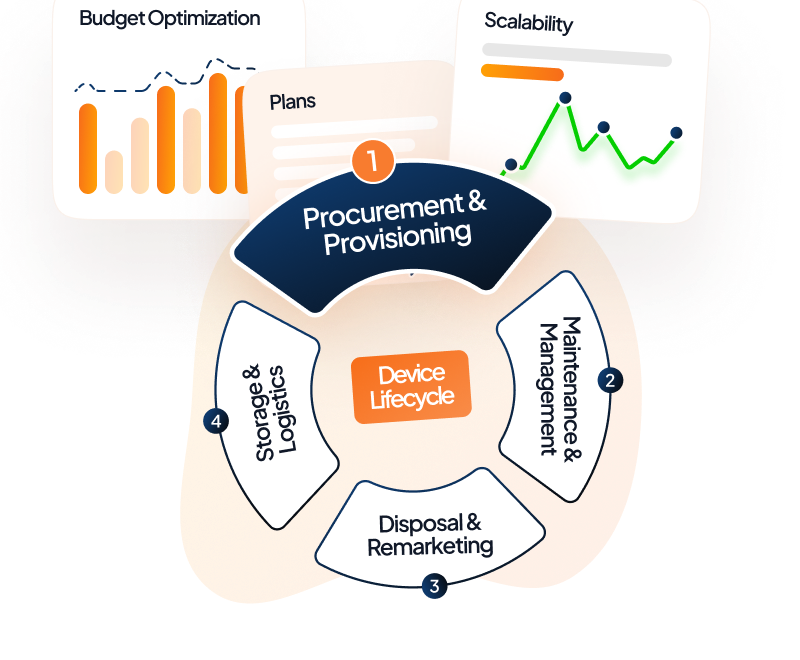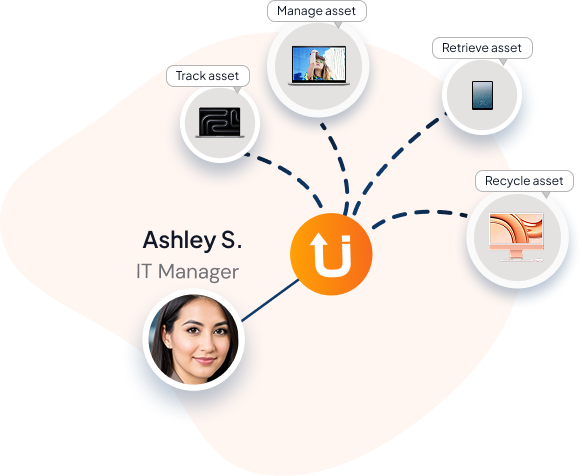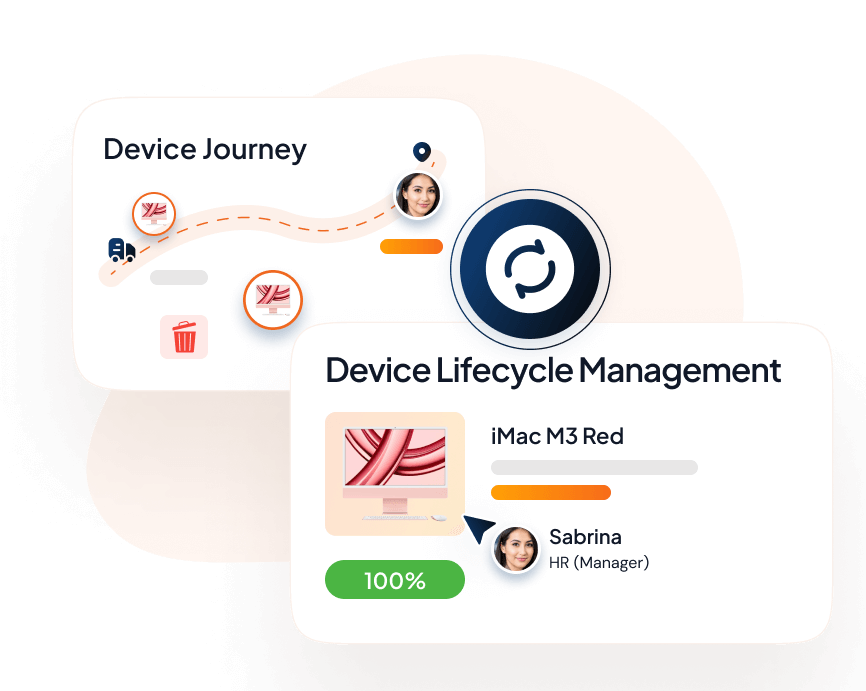If you’re an IT manager, you know being responsible for keeping track of hundreds, if not thousands, of devices across multiple locations isn’t easy. You’ve got laptops, desktops, printers, and more to manage. This tedious, time-consuming task not only leaves you frustrated but also raises concerns about record accuracy and security compliance. You’re not alone in this struggle. Many businesses face similar complexities with hardware asset management, particularly when trying to align with Security Frameworks like NIST Guidelines.
Fortunately, implementing effective hardware asset management tools can significantly streamline these processes while helping your organization maintain proper security compliance standards. In this article we will cover top tools and strategies to manage hardware effectively across the enterprise.
Key Takeaways
- HAM optimizes IT hardware lifecycle, from acquisition to eco-friendly disposal, ensuring efficiency.
- Asset types includes end-user devices (laptops, phones), networking, data center hardware, peripherals, and maintenance parts./li>
- Top HAM tools are InvGate, ManageEngine, ServiceNow, Ivanti, BMC Helix, and Unduit automate tracking and lifecycle management
- HAM process stages involve discovery, procurement, deployment, maintenance, inventory, tracking, and responsible retirement.
- HAM helps in boosting operational efficiency, cuts costs, ensures compliance, and enhances decision-making with accurate asset data.
- Regular audits, automation, clear roles, asset recovery, and eco-friendly disposal optimize HAM processes.
What is Hardware Asset Management (HAM)?
Before we dive into the tools and practices it is really important to understand what hardware asset management is. Hardware asset management (HAM) is the comprehensive process of managing and optimizing the physical components of an organization’s IT infrastructure.
This includes tracking, deploying, maintaining, upgrading, and disposing of hardware assets to ensure maximum efficiency and cost-effectiveness. HAM encompasses the entire lifecycle of hardware assets, from acquisition to disposal, providing a clear overview of an organization’s hardware inventory and its utilization.

Types of Hardware Assets
A common misconception is that hardware asset management begins and ends with supplying laptops to new hires. However, this is only a small part of the picture. When we talk about hardware assets, we’re dealing with a few distinct categories of devices and items.
In the context of HAM, company IT equipment is categorized into three main groups:
- IT Hardware Assets: Laptops, desktops, servers, routers, switches, and other physical devices.
- Commodities: Consumables like cables, batteries, and other peripheral components.
- Exclusions: Items not considered as assets, such as disposable supplies or short-term rentals.
Hardware assets are generally grouped into four primary categories:
- End-User Devices: Laptops, desktops, phones.
- Networking & Infrastructure: Servers, routers, switches, cables, load balancers.
- Data Center Hardware: Storage and access hardware required for data centers.
- Peripherals: Monitors, keyboards, printers, pen drives, scanners.
- Accessories: Laptop stands, bags, and other related items.
- Maintenance and Parts Inventories: Tools and components required to maintain the IT environment.
Top 5 Hardware Asset Management Tools
When selecting a hardware asset management tool, consider the specific needs of your organization. Here are five top tools to consider:
- Unduit IT Asset Management: Provides you with the comfort of automation and globalization so you can easily manage and maintain your hardware assets throughout their lifecycle.
- InvGate Assets: Offers comprehensive asset tracking and management features, making it easy to maintain an accurate asset inventory and lifecycle management.
- ManageEngine AssetExplorer: Provides detailed asset inventory and lifecycle management, helping you manage hardware and software assets efficiently.
- ServiceNow Asset Management: Integrates with IT service management for streamlined processes and better asset utilization.
- Ivanti IT Asset Management: Combines hardware and software asset management for a holistic approach to asset management.
Process and Stages of HAM
Hardware asset management is not just a one-time project, it is a continuous process with several stages and steps
- Asset Discovery: Identifying and cataloging all hardware assets within the organization.
- Procurement: Acquiring new hardware assets based on organizational needs.
- Deployment: Distributing and installing hardware assets to end-users or locations.
- Maintenance: Regularly servicing and updating hardware to ensure optimal performance.
- Inventory Management: Keeping detailed records of all hardware assets, including their status and location.
- Asset Tracking: Monitoring the usage and movement of hardware assets.
- Retirement and Disposal: Safely disposing of obsolete or non-functional hardware assets, often through eco-friendly methods.
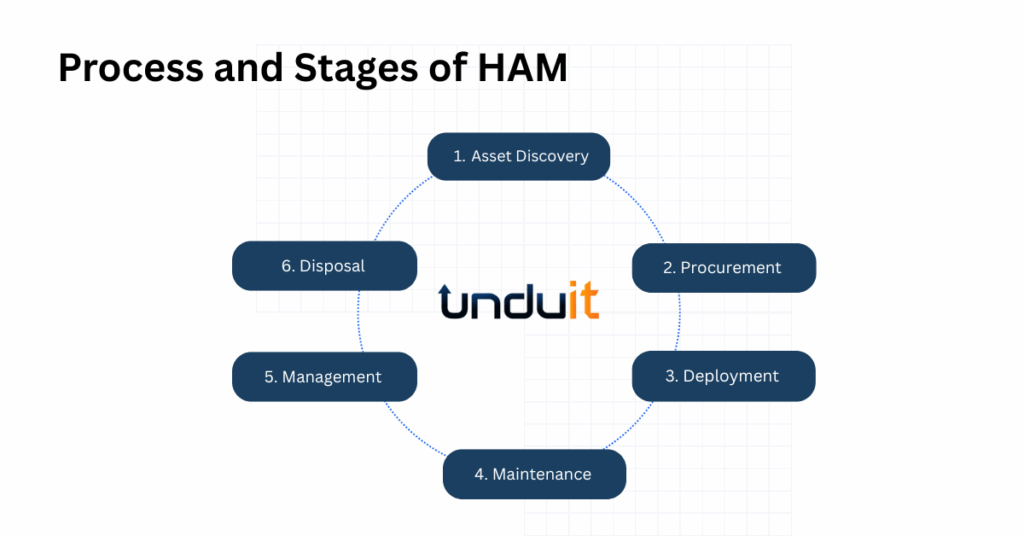
Key Features of Hardware Asset Management Tools
The right hardware asset management tools come packed with features designed to simplify your asset management process. From asset tracking and asset inventory management to asset discovery and asset lifecycle management, these tools cover it all. Here are some key features to look for:
- Asset Tracking: Keep tabs on every hardware asset, whether it’s in use, in storage, or out for repair. Asset tracking software ensures you always know the status and location of your hardware.
- Asset Inventory Management: Maintain a comprehensive asset inventory, allowing for quick access to detailed information about each hardware asset.
- Asset Lifecycle Management: Track each asset through its entire lifecycle—from acquisition to disposal—ensuring optimal asset utilization and timely upgrades or replacements.
- Configuration Management: Manage hardware configurations to ensure compliance and streamline service management processes.
- Contract Management: Keep track of warranties, service agreements, and other contracts related to your hardware assets.
- Asset Discovery: Automatically identify and catalog new assets as they are added to your network, ensuring nothing is missed.
Why is HAM important to the organization?
Hardware asset management is about maintaining an accurate and up-to-date hardware asset inventory. HAM helps in leveraging easy to use information to improve operational operational efficiency, reduce costs, and make informed decisions.
- Operational Efficiency: Automate routine tasks, reduce manual errors, and free up valuable time for your IT team.
- Cost Savings: Avoid unnecessary purchases by efficiently utilizing existing assets and minimizing the risk of lost or stolen equipment.
- Informed Decision-Making: Access detailed asset data to make strategic decisions about hardware investments, maintenance schedules, and more.
- Enhanced Compliance: Ensure compliance with industry regulations and internal policies through detailed asset records and audit trails.
- Improved Service Management: Integrate with your service desk to streamline incident and request management, providing faster resolutions and better support.
Key Challenges in Hardware Asset Management

Despite the many benefits, hardware asset management comes with its own set of challenges:
- Accurate Tracking: Ensuring all assets are accurately tracked and recorded can be difficult, especially in large organizations.
- Asset Utilization: Maximizing the use of each asset to avoid unnecessary purchases and underutilized hardware.
- Lifecycle Management: Effectively managing the entire lifecycle of assets, from acquisition to disposal.
- Compliance: Adhering to industry regulations and internal policies.
- Disposal: Safely and responsibly disposing of obsolete assets.
Best Practices in Hardware Asset Management
To overcome the above-mentioned challenges and ensure effective hardware asset management, follow these best practices:
1. Data and Physical Audits:
Regularly verify that equipment matches records in the ITAM database. Ensure that:
- Equipment is assigned to the person identified in the ITAM database.
- The equipment is in the location identified in the ITAM database.
- The serial number and asset tag affixed to the equipment match the record in the ITAM database.
- The equipment’s status in the ITAM database reflects its current status.
- The equipment’s purchase date, warranty information, and cost have been recorded.
2. Automated HAM
Use automation tools to streamline asset management processes, reducing manual errors and saving time.
3. Assign Proper Roles and Responsibilities
Ensure clear ownership and accountability for asset management tasks within your organization.
4. Focus on Asset Recovery
Maximize the recovery value of retired assets through effective asset recovery processes.
5. Eco-Friendly Disposal
Dispose of hardware in an environmentally responsible manner, ensuring compliance with environmental regulations.
Hardware Asset Management KPIs
Studies show that only 23% of organizations have identified measurable KPIs for asset management to measure the effectiveness of their hardware asset management processes, it is very important to define the right KPIs to measure the effectiveness of your asset management.
- Asset Utilization Rate: Measures the percentage of assets actively in use, indicating how well you are utilizing your hardware resources.
- Compliance Rate: Tracks adherence to regulatory and policy requirements, ensuring your asset management practices meet necessary standards.
- Asset Recovery Value: Measures the value recovered from retired assets, indicating the effectiveness of your asset recovery processes.
- Incident Resolution Time: Tracks the time taken to resolve hardware-related incidents, providing insights into the efficiency of your service desk and support processes.
- Inventory Accuracy: Measures the accuracy of asset records in the ITAM database, ensuring your asset data is reliable and up-to-date.
“Leveraging advanced HAM tools and following best practices, businesses can ensure their hardware assets are efficiently managed, cost-effective, and aligned with their overall goals. Embrace the power of hardware asset management tools and transform the way you manage your valuable assets”
Unduit All in one IT Asset Management
Get complete, accurate, and real-time insight into your managed IT assets to reduce costs, increase productivity, and improve security with Unduit Asset Management Platform.
- Automate IT asset discovery and management
- Act on real-time IT asset information.
- Easily group, find, and manage assets.
- Track and alert on asset changes.
- Monitor and manage software at scale.

Frequently Asked Questions (FAQ)
1. What criteria should I use to choose a hardware asset management tool?
When selecting a hardware asset management tool, consider factors such as scalability, ease of use, integration capabilities, cost, customer support, and specific features that align with your organization’s needs.
2. How can I ensure data security in hardware asset management?
Data security can be ensured through measures such as encryption, access control, regular audits, and compliance with data protection regulations.
3. What are the cost considerations when implementing a hardware asset management tool?
Cost considerations include the initial purchase price, subscription fees, implementation costs, training expenses, and potential savings from improved efficiency and reduced asset loss.
4. How often should hardware assets be audited?
Regular audits should be conducted at least annually, but more frequent audits (e.g., quarterly) can provide better accuracy and control over hardware assets.
5. What are the environmental benefits of proper hardware asset management?
Proper hardware asset management can reduce electronic waste, promote recycling and reuse, and ensure environmentally friendly disposal of obsolete equipment.
6. Can hardware asset management tools help with software license management?
Many hardware asset management tools also offer features for software license management, helping ensure compliance and optimize software usage.
7. What role does cloud technology play in hardware asset management?
Cloud-based HAM tools offer benefits such as remote access, scalability, real-time updates, and reduced infrastructure costs.
8. What types of assets are included in HAM?
HAM includes various types of fixed assets such as end-user devices (laptops, desktops, phones), networking & infrastructure (servers, routers, switches), data center hardware, peripherals (monitors, printers), accessories (laptop stands, bags), and maintenance and parts inventories.
9. What are the stages of hardware asset management?
The stages include asset discovery, procurement, deployment, maintenance, inventory management, asset tracking, and retirement and disposal.
10. How can I ensure accurate tracking of hardware assets?
Use asset tag, barcode scanners, and asset tracking software to monitor the location, status, and condition of each asset. Regularly conduct data and physical audits to verify that equipment matches records in your IT asset management (ITAM) database.
11. What key performance indicators (KPIs) should I track in HAM?
Track KPIs such as asset utilization rate, compliance rate, asset recovery value, incident resolution time, and inventory accuracy to measure the effectiveness of your hardware asset management process.
12. How do ITLM, ITAD, and HAM work together?
ITLM provides the overall framework for managing IT assets, ITAD ensures secure and responsible disposal of assets, and HAM focuses on the physical aspects of asset management. Together, they provide a comprehensive approach to IT asset management.
